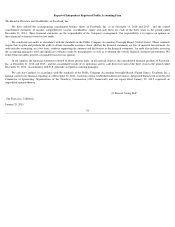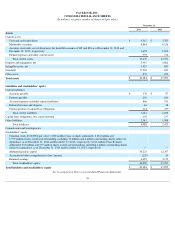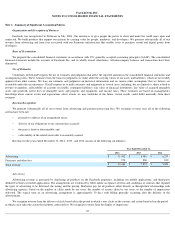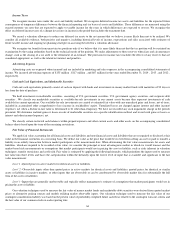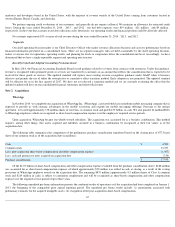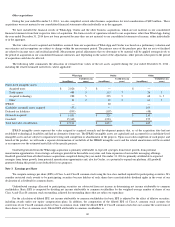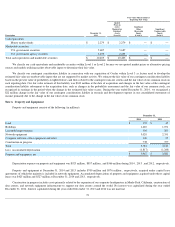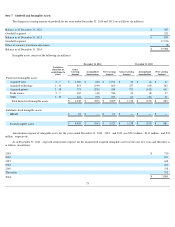Facebook 2014 Annual Report Download - page 67
Download and view the complete annual report
Please find page 67 of the 2014 Facebook annual report below. You can navigate through the pages in the report by either clicking on the pages listed below, or by using the keyword search tool below to find specific information within the annual report.
based ads in the contracted period in which the impressions are delivered. Impressions are considered delivered when an ad is displayed to users.
Payments and Other Fees
We enable Payments from people to purchase virtual and digital goods from our developers. People can transact and make payments on the
Facebook website by using debit cards and credit cards, PayPal, mobile phone payments, gift cards, or other methods.
When a person engages in a payment transaction for the purchase of a virtual or digital good from a developer, we remit to the developer an
amount that is based on the total amount of the transaction less the processing fee that we charge the developer. The price of the purchase is an amount
that is solely determined by the developer. Our revenue is the net amount of the transaction, representing our processing fee for the service performed.
We record revenue on a net basis as we do not consider ourselves to be the principal in the sale of the virtual or digital good to the person. Additionally,
we record all Payments revenue at the time of the purchase of the related virtual goods, net of estimated refunds or chargebacks
Other fees, which includes our ad serving and measurement products and the delivery of virtual reality platform devices, were not material in all
periods presented in our financial statements.
Revenue is recognized net of applicable sales and other taxes.
Cost of Revenue
Our cost of revenue consists primarily of expenses associated with the delivery and distribution of our products. These include expenses related to
the operation of our data centers such as facility and server equipment depreciation, facility and server equipment rent expense, energy and bandwidth
costs, support and maintenance costs, and salaries, benefits, and share-
based compensation for employees on our operations teams. Cost of revenue also
includes credit card and other transaction fees related to processing customer transactions, amortization of intangible assets, and cost of virtual reality
platform device inventory sold.
Share-based Compensation
We account for share-
based employee compensation plans under the fair value recognition and measurement provisions of GAAP. Those
provisions require all share-
based payments to employees, including grants of stock options and restricted stock units (RSUs), to be measured based on
the grant date fair value of the awards, with the resulting expense generally recognized on a straight-
line basis in our consolidated statements of income
over the period during which the employee is required to perform service in exchange for the award. The majority of our awards are earned over a
service period of four to five years .
Share-
based compensation expense is recorded net of estimated forfeitures in our consolidated statements of income and as such, only those
share-
based awards that we expect to vest are recorded. We estimate the forfeiture rate based on historical forfeitures of equity awards and adjust the
rate to reflect changes in facts and circumstances, if any. We will revise our estimated forfeiture rate if actual forfeitures differ from our initial estimates.
We have historically issued unvested restricted shares to employee stockholders of certain acquired companies. As these awards are generally
subject to continued post-acquisition employment, we have accounted for them as post-acquisition share-
based compensation expense. We recognize
compensation expense equal to the grant date fair value of the common stock on a straight-
line basis over the period during which the employee is
required to perform service in exchange for the award.
During the years ended December 31, 2014 , 2013 , and 2012 , we realized tax benefits from share-based award activity of $1.85 billion ,
$602
million , and $1.03 billion , respectively. These amounts reflect the extent that the total reduction to our income tax liability from share-
based award
activity was greater than the amount of the deferred tax assets that we had previously recorded in anticipation of these benefits. These amounts are the
aggregate of the individual transactions in which the reduction to our income tax liability was greater than the deferred tax assets that we recorded,
reduced by any individual transactions in which the reduction to our income tax liability was less than the deferred tax assets that were recorded. These
net amounts were recorded as an adjustment to stockholders' equity in each period, as an increase to cash flows from operating activities, and were not
recognized in our consolidated statements of income.
In addition, we reported excess tax benefits that decreased our cash flows from operating activities and increased our cash flows from financing
activities for the years ended December 31, 2014 , 2013 , and 2012 , by $1.87 billion , $609 million , and $1.03 billion
, respectively. The amounts of
these excess tax benefits reflect the total of the individual transactions in which the reduction to our income tax liability was greater than the deferred tax
assets that were recorded, but were not reduced by any of the individual transactions in which the reduction to our income tax liability was less than the
deferred tax assets that were recorded.
63


